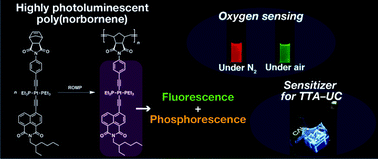Highly photoluminescent poly(norbornene)s carrying platinum–acetylide complex moieties in their side chains: evaluation of oxygen sensing and TTA–UC†
Abstract
Ring-opening metathesis polymerization (ROMP) of norbornene derivatives is useful for preparing thermally stable and transparent polymeric materials with good moldability. This study deals with the ROMP of the norbornene monomer 1 bearing a platinum(Pt)–acetylide complex moiety using the Grubbs third-generation catalyst. The product, poly(norbornene) [poly(1)], was investigated as a sensitizer for triplet–triplet annihilation upconversion (TTA–UC), together with the copolymers of 1 and 2-norbornene 2. All the polymers exhibited bright photoluminescence under N2. The phosphorescence of poly(1) was remarkably quenched, while that of poly(1-co-2)s was hardly quenched in CHCl3 solution. The phosphorescence of cast films of the polymers was highly responsive to oxygen, indicating possible application as oxygen sensing materials. The luminescence colors of the films were tunable between yellow and orange by copolymerization of 2 as a matrix. The polymers served as excellent sensitizers of TTA–UC with 9,10-diphenylanthracene as an emitter.



 Please wait while we load your content...
Please wait while we load your content...